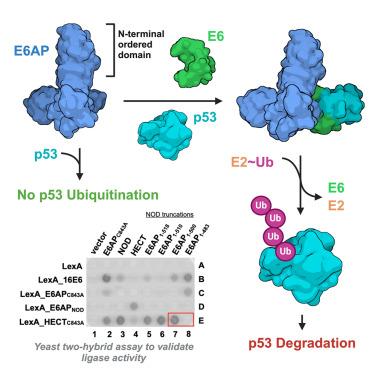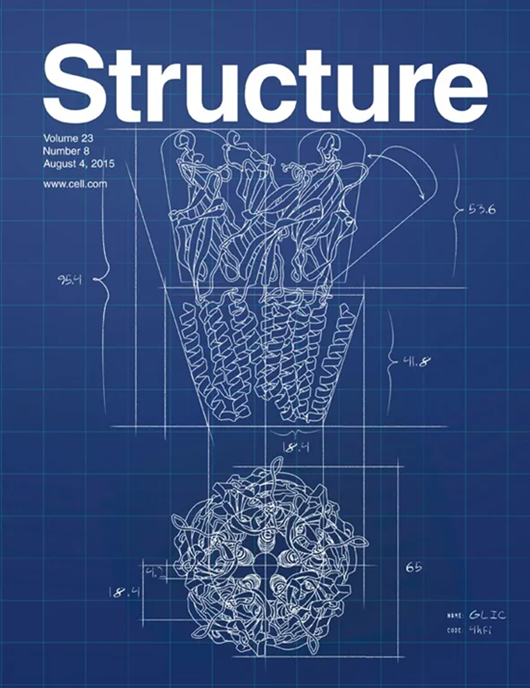Structure of E6AP in complex with HPV16-E6 and p53 reveals a novel ordered domain important for E3 ligase activation
IF 4.4
2区 生物学
Q2 BIOCHEMISTRY & MOLECULAR BIOLOGY
引用次数: 0
Abstract
High-risk human papillomavirus E6 oncoprotein is a model system for the recognition and degradation of cellular p53 tumor suppressor protein. There remains a gap in the understanding of the ubiquitin transfer reaction, including placement of the E6AP catalytic HECT domain of the ligase concerning the p53 substrate and how E6 itself is protected from ubiquitination. We determined the cryoelectron microscopy (cryo-EM) structure of the E6AP/E6/p53 complex, related the structure to in vivo modeling of the tri-molecular complex, and identified structural interactions associated with activation of the ubiquitin ligase function. The structure reveals that the N-terminal ordered domain (NOD) in E6AP has a terminal alpha helix that mediates the interaction of the NOD with the HECT domain of E6AP and protects the HPV-E6 protein from ubiquitination. In addition, this NOD helix is required for E6AP ligase function by contributing to the affinity of the E6-E6AP association, modulating E6 substrate recognition, while displacing UbcH7.

E6AP与HPV16-E6和p53复合物的结构揭示了对E3连接酶激活非常重要的新型有序结构域
高危人乳头瘤病毒E6癌蛋白是细胞p53肿瘤抑制蛋白识别和降解的模型系统。对泛素转移反应的理解仍然存在空白,包括与p53底物有关的连接酶的E6AP催化HECT结构域的位置以及E6本身如何免受泛素化的保护。我们确定了E6AP/E6/p53复合体的低温电镜(cryo-EM)结构,将结构与三分子复合体的体内建模联系起来,并确定了与泛素连接酶功能激活相关的结构相互作用。该结构揭示了E6AP的n端有序结构域(NOD)具有末端α螺旋,可介导NOD与E6AP的HECT结构域的相互作用,并保护HPV-E6蛋白免于泛素化。此外,这个NOD螺旋是E6AP连接酶功能所必需的,通过促进E6-E6AP结合的亲和力,调节E6底物识别,同时取代UbcH7。
本文章由计算机程序翻译,如有差异,请以英文原文为准。
求助全文
约1分钟内获得全文
求助全文
来源期刊

Structure
生物-生化与分子生物学
CiteScore
8.90
自引率
1.80%
发文量
155
审稿时长
3-8 weeks
期刊介绍:
Structure aims to publish papers of exceptional interest in the field of structural biology. The journal strives to be essential reading for structural biologists, as well as biologists and biochemists that are interested in macromolecular structure and function. Structure strongly encourages the submission of manuscripts that present structural and molecular insights into biological function and mechanism. Other reports that address fundamental questions in structural biology, such as structure-based examinations of protein evolution, folding, and/or design, will also be considered. We will consider the application of any method, experimental or computational, at high or low resolution, to conduct structural investigations, as long as the method is appropriate for the biological, functional, and mechanistic question(s) being addressed. Likewise, reports describing single-molecule analysis of biological mechanisms are welcome.
In general, the editors encourage submission of experimental structural studies that are enriched by an analysis of structure-activity relationships and will not consider studies that solely report structural information unless the structure or analysis is of exceptional and broad interest. Studies reporting only homology models, de novo models, or molecular dynamics simulations are also discouraged unless the models are informed by or validated by novel experimental data; rationalization of a large body of existing experimental evidence and making testable predictions based on a model or simulation is often not considered sufficient.
 求助内容:
求助内容: 应助结果提醒方式:
应助结果提醒方式:


